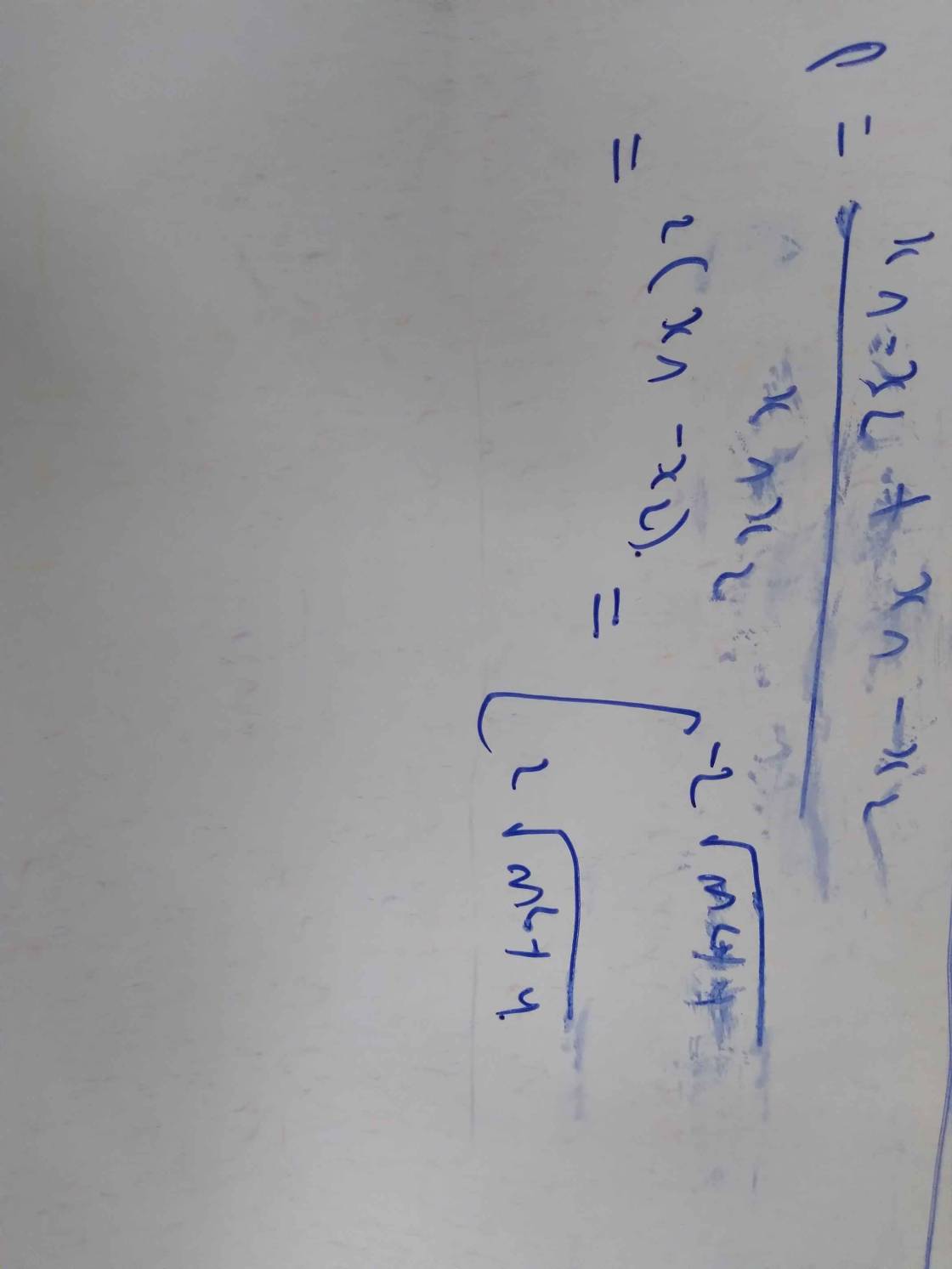Hãy nhập câu hỏi của bạn vào đây, nếu là tài khoản VIP, bạn sẽ được ưu tiên trả lời.

\(x^2 - 4x - 3 = 0\) có 1.(-3) < 0
=> Phương trình có hai nghiệm phân biệt
Áp dụng hệ thức Vi-et có \(x_1 + x_2 = 4\) \(; x_1x_2 = -3\)
Mà \(A = \dfrac{x_1^2}{x_2} + \dfrac{x_2^2}{x_1}\)
\(= \dfrac{x_1^3 + x_2^3}{x_1x_2}\)
\(= \dfrac{(x_1 + x_2)(x_1^2 - x_1x_2 + x_2^2)}{x_1x_2}\)
\(=\dfrac{(x_1+x_2)[(x_1 +x_2)^2 - 3x_1x_2]}{x_1x_2}\)
\(=\dfrac{4.[4^2 - 3.(-3)]}{-3}\)
\(= \dfrac{-100}{3}\)

Phương trình : \(x^2-2mx+2m-3=0\left(1\right)\)
Xét : \(\Delta=m^2-\left(2m-3\right)=m^2-2m+3=m^2-2m+1+2=\left(m-1\right)^2+2>0,\forall m\)
=> Phương trình 1 luôn có 2 ngiệm phân biệt x1, x2
\(A=x_1^2+x_2^2=x_1^2+2x_1x_2+x_2^2-2x_1x_2=\left(x_1+x_2\right)^2-2x_1x_2\)
Áp dụng định lí Vi ét cho phương trình (1) Ta có:
x1+x2=2m; x1.x2=2m-3
Khi đó: \(A=\left(2m\right)^2-2.\left(2m-3\right)=\left(2m\right)^2-2.2m+1+5=\left(2m-1\right)^2+5\ge5\)
'=" xảy ra <=> 2m-1=0 <=> m=1/2
Vậy : min A=5 khi và chỉ khi m=1/2

1. Theo hệ thức Vi-ét, ta có: \(\left\{{}\begin{matrix}x_1+x_2=-\dfrac{4}{3}\\x_1.x_2=\dfrac{1}{3}\end{matrix}\right.\)
\(C=\dfrac{x_1}{x_2-1}+\dfrac{x_2}{x_1-1}=\dfrac{x_1\left(x_1-1\right)+x_2\left(x_2-1\right)}{\left(x_1-1\right)\left(x_2-1\right)}\)
\(=\dfrac{x_1^2-x_1+x_2^2-x_2}{x_1x_2-x_1-x_2+1}=\dfrac{\left(x_1+x_2\right)^2-2x_1x_2-\left(x_1+x_2\right)}{x_1x_2-\left(x_1+x_2\right)+1}\)
\(=\dfrac{\left(-\dfrac{4}{3}\right)^2-2.\dfrac{1}{3}-\left(-\dfrac{4}{3}\right)}{\dfrac{1}{3}-\left(-\dfrac{4}{3}\right)+1}=\dfrac{\dfrac{22}{9}}{\dfrac{8}{3}}=\dfrac{11}{12}\)
\(1,3x^2+4x+1=0\)
Do pt có 2 nghiệm \(x_1,x_2\) nên theo đ/l Vi-ét ta có :
\(\left\{{}\begin{matrix}S=x_1+x_2=\dfrac{-b}{a}=-\dfrac{4}{3}\\P=x_1x_2=\dfrac{c}{a}=\dfrac{1}{3}\end{matrix}\right.\)
Ta có :
\(C=\dfrac{x_1}{x_2-1}+\dfrac{x_2}{x_1-1}\)
\(=\dfrac{x_1\left(x_1-1\right)+x_2\left(x_2-1\right)}{\left(x_2-1\right)\left(x_1-1\right)}\)
\(=\dfrac{x_1^2-x_1+x_2^2-x_2}{x_1x_2-x_2-x_1+1}\)
\(=\dfrac{\left(x_1^2+x_2^2\right)-\left(x_1+x_2\right)}{x_1x_2-\left(x_1+x_2\right)+1}\)
\(=\dfrac{S^2-2P-S}{P-S+1}\)
\(=\dfrac{\left(-\dfrac{4}{3}\right)^2-2.\dfrac{1}{3}-\left(-\dfrac{4}{3}\right)}{\dfrac{1}{3}-\left(-\dfrac{4}{3}\right)+1}\)
\(=\dfrac{11}{12}\)
Vậy \(C=\dfrac{11}{12}\)

Theo Vi-ét, ta có:
\(\left\{{}\begin{matrix}x_1+x_2=-\dfrac{b}{a}=-\dfrac{3}{4}\\x_1x_2=\dfrac{c}{a}=-\dfrac{1}{4}\end{matrix}\right.\)
\(A=-2\left(x_1-2\right)\left(x_2-2\right)\)
\(=\left(-2x_1+4\right)\left(x_2-2\right)\)
\(=-2x_1x_2+4x_1+4x_2-8\)
\(=-2x_1x_2+4\left(x_1+x_2\right)-8\)
\(=-2.\left(-\dfrac{1}{4}\right)+4.\left(-\dfrac{3}{4}\right)-8\)
\(=\dfrac{1}{2}-3-8\)
\(=\dfrac{1}{2}-11\)
\(=-\dfrac{21}{2}\)

\(\left(m-1\right)x^2-2mx+m-4=0\)
Theo Vi - ét , ta có :
\(\left\{{}\begin{matrix}x_1+x_2=-\dfrac{b}{a}=\dfrac{2m}{m-1}\\x_1x_2=\dfrac{c}{a}=\dfrac{m-4}{m-1}\end{matrix}\right.\)
Ta có :
\(A=3\left(x_1+x_2\right)+2x_1x_2-8\)
\(=3\left(\dfrac{2m}{m-1}\right)+2\left(\dfrac{m-4}{m-1}\right)-8\)
\(=\dfrac{6m}{m-1}+\dfrac{2m-8}{m-1}-8\)
\(=\dfrac{6m+2m-8}{m-1}-8\)
\(=\dfrac{8m-8}{m-1}-8\)
\(=\dfrac{8\left(m-1\right)}{m-1}-8\)
\(=8-8\)
\(=0\)
Vậy biểu thức A không phụ thuộc giá trị m

Vì \(x_1\) là nghiệm PT nên \(x_1^2+3x_1-7=0\Leftrightarrow x_1^2=7-3x_1\)
\(F=x_1^2-3x_2-2013=7-3x_1-3x_2-2013\\ F=-3\left(x_1+x_2\right)-2006\)
Mà theo Viét ta có \(x_1+x_2=-3\)
\(\Rightarrow F=\left(-3\right)\left(-3\right)-2006=-1997\)

`x^2-2x-sqrt3+1=0`
Vì `Delta=1+sqrt3-1>0`
`=>` pt có 2 nghiệm pb
ÁP dụng vi-ét:
`x_1+x_2=2,x_1.x_2=1-sqrt3`
`M=x_1^2x_2^2-2x_1.x_2-x_1-x_2`
`=(x_1.x_2)^2-2(x_1.x_2)-(x_1+x_2)`
`=(sqrt3-1)^2-2(1-sqrt3)-2`
`=4-2sqrt3-2+2sqrt3-2`
`=0`


Nhầm mất :v
\(\left(x_1+x_2\right)^3-3x_1x_2\left(x_1+x_2\right)=2^3-3.\left(-2\right).2=20\)
Pha cuối hơi sai : sửa
A = \(2\left(2^2-3.\left(-2\right)\right)=2\left(4+6\right)=2.10=20\)